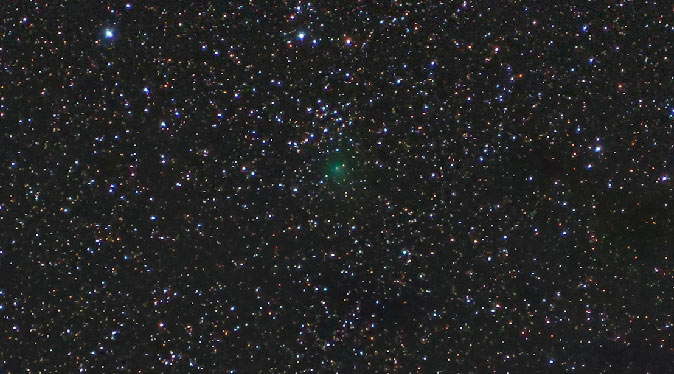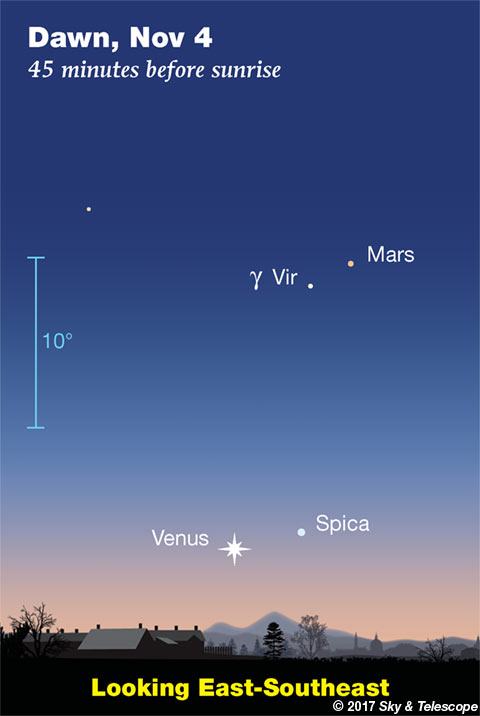Comet ASASSN1, whose path is plotted in the November Sky & Telescope (page 48), is turning out to be only 9th or 10th magnitude even now at its predicted peak brightness. It's there, but it needs a medium-sized telescope (or supersize binoculars under a really dark sky). Its reported visual magnitudes vary rather widely, depending on sky conditions and the instrument used. Try for it early in the week, after moonset in the early-morning hours.

Friday, October 27
• First-quarter Moon (exactly first-quarter at 6:22 p.m. Eastern Daylight Time). At nightfall you'll find Altair shining about 30° (three fists at arm's length) to the Moon's upper right.
Much closer to the Moon's upper right, by only about 6°, are 3rd-magnitude Alpha and Beta Capricorni. Alpha is the upper one. Can you resolve Alpha into a tiny twin pair with your unaided eyes? Binoculars make it easy — and should also resolve Beta, another wide double, although its components are closer and very unequal.
• Look for Capella sparkling low in the northeast after dinnertime this week. Then find the little Pleiades cluster to its right, by about three fists at arm's length. They rise higher as evening grows late, harbingers of the cold months to come.
Upper right of Capella, and upper left of the Pleiades, the stars of Perseus stand astride the Milky Way. To the upper left of Perseus, the Milky Way runs through Cassiopeia.
Saturday, October 28
• Now Altair appears a little farther to the Moon's upper right after dark. Just upper right of Altair, by a finger-width at arm's length, is orange Tarazed. It looks like Altair's little sidekick, but it's actually a much bigger and brighter star far in the background. Altair is 17 light-years away. Tarazed is about 360 light-years away and 100 times as luminous.
• And hey, it's International Observe the Moon Night!
Sunday, October 29
• Spot Altair high in the southwest soon after dark. Two distinctive little constellations lurk above it: Delphinus the Dolphin, hardly more than a fist at arm's length to Altair's upper left, and fainter Sagitta the Arrow, slightly less far to Altair's upper right. Sky too bright with moonlight? Use binoculars!

Monday, October 30
• The Big Dipper lies down horizontal low in the north-northwest after dark.
How low? The farther south you are, the lower. Seen from 40° north (New York, Denver) even its bottom stars twinkle nearly ten degrees high. But at Miami (26° N) the entire Dipper skims along out of sight just below the northern horizon.
Tuesday, October 31
• For this Halloween evening, a bright waxing gibbous Moon shines in the southeast to south. It's lower right of the Great Square of Pegasus at dusk, and directly below it later in the evening. The Great Square is about 15° on a side, somewhat larger than your fist at arm's length.
Wednesday, November 1
• The bright Moon is below the Great Square of Pegasus. Look to the Moon's left by about three fists at arm's length for the two or three brightest stars of Aries, lined up roughly horizontal.
Thursday, November 2
• Vega is the brightest star in the west on November evenings. Its little constellation Lyra extends to its left, pointing in the direction of Altair, the brightest star in the southwest.
Three of Lyra's leading stars, after Vega, are interesting doubles. Barely above Vega is 4th-magnitude Epsilon Lyrae, the Double-Double. Epsilon forms one corner of a roughly equilateral triangle with Vega and Zeta Lyrae. The triangle is less than 2° on a side, hardly the width of your thumb at arm's length. It easily fits in a binocular's field of view.
Binoculars easily resolve Epsilon. And a 4-inch telescope at 100× or more should resolve each of Epsilon's wide components into a tight pair.
Zeta Lyrae is also a double star for binoculars; much tougher, but plainly resolved in any telescope.
Delta Lyrae, upper left of Zeta, is a much wider and easier pair.
Friday, November 3
• Full Moon tonight (exactly full at 1:23 a.m.). The full Moon of November always rides very high in the middle of the night, almost as high as the full Moon of December.
Saturday, November 4
• Look lower left of the bright Moon this evening for Aldebaran. Above Aldebaran are the Pleiades, perhaps not so easy to spot in the moonlight. Bring binoculars.
The bright star much farther to the left is Capella.
• Standard time returns at 2 a.m. Sunday morning for most of North America. Clocks fall back an hour.
________________________
Want to become a better astronomer? Learn your way around the constellations! They're the key to locating everything fainter and deeper to hunt with binoculars or a telescope.
This is an outdoor nature hobby. For an easy-to-use constellation guide covering the whole evening sky, use the big monthly map in the center of each issue of Sky & Telescope, the essential guide to astronomy.

Once you get a telescope, to put it to good use you'll need a detailed, large-scale sky atlas (set of charts). The basic standard is the Pocket Sky Atlas (in either the original or Jumbo Edition), which shows stars to magnitude 7.6.
Next up is the larger and deeper Sky Atlas 2000.0, plotting stars to magnitude 8.5; nearly three times as many. The next up, once you know your way around, is the even larger Uranometria 2000.0 (stars to magnitude 9.75). And read how to use sky charts with a telescope.
You'll also want a good deep-sky guidebook, such as Sue French's Deep-Sky Wonders collection (which includes its own charts), Sky Atlas 2000.0 Companion by Strong and Sinnott, or the bigger Night Sky Observer's Guide by Kepple and Sanner.
Can a computerized telescope replace charts? Not for beginners, I don't think, and not on mounts and tripods that are less than top-quality mechanically (meaning heavy and expensive). And as Terence Dickinson and Alan Dyer say in their Backyard Astronomer's Guide, "A full appreciation of the universe cannot come without developing the skills to find things in the sky and understanding how the sky works. This knowledge comes only by spending time under the stars with star maps in hand."
This Week's Planet Roundup
Mercury is hidden deep in the afterglow of sunset.
Venus (magnitude –3.9) rises as dawn begins and shines very low due east as dawn brightens.
Mars (magnitude +1.8, in Virgo) is higher in the dawn, well to the upper right of Venus. Their separation grows a bit from 14° on October 28th to 16° by November 4th. Venus is getting lower, Mars higher.
Jupiter is hidden deep in the glow of sunrise.
Saturn (magnitude +0.5, in southern Ophiuchus) glows very low in the southwest at dusk.
Uranus (magnitude 5.7, in Pisces) and Neptune (magnitude 7.8, in Aquarius) are well up after dark in the southeastern side of the sky. Neptune is less than 1° from Lambda Aquarii. Use our finder charts online or in the October Sky & Telescope, page 50.
______________________
All descriptions that relate to your horizon — including the words up, down, right, and left — are written for the world's mid-northern latitudes. Descriptions that also depend on longitude (mainly Moon positions) are for North America.
Eastern Daylight Time (EDT) is Universal Time (UT, UTC, GMT, or Z time) minus 4 hours.
______________________
"This adventure is made possible by generations of searchers strictly adhering to a simple set of rules. Test ideas by experiments and observations. Build on those ideas that pass the test. Reject the ones that fail. Follow the evidence wherever it leads, and question everything. Accept these terms, and the cosmos is yours."
— Neil deGrasse Tyson, 2014
______________________
"Objective reality exists. Facts are often determinable. Vaccines save lives. Carbon dioxide warms the globe. Bacteria evolve to thwart antibiotics, because evolution. Science and reason are not fake, are not a political conspiracy. They are how we discover reality. Civilization's survival depends on our ability, and willingness, to use them."
— Alan MacRobert, your Sky at a Glance editor
______________________
"Facts are stubborn things."
— John Adams, 1770
 1
1








Comments
October 27, 2017 at 8:15 pm
"Saturday, November 4
• Look lower left of the bright Moon this evening for Aldebaran. Above Aldebaran are the Pleiades, perhaps not so easy to spot in the moonlight. Bring binoculars."
*****
Although the event occurs after this entry's timeframe, the just-past-Full Moon occults Aldebaran for the Eastern US and Canada after moonrise on Sunday evening Nov 5. For Europe, the event occurs before moonset on Monday morning November 6. Disappearance occurs on the moonlit edge. For the central US/Canada, the occultation has begun before moonrise, but viewers can watch the Aldebaran emerge on the dark limb after moonrise (event will occur with the Moon and star low on horizon).
IOTA has a map and disappearance/reappearance time (UT) here: http://www.lunar-occultations.com/iota/bstar/1106zc692.htm
You must be logged in to post a comment.
You must be logged in to post a comment.